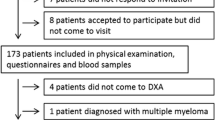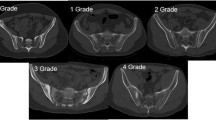Abstract
The purpose of this study is to evaluate bone mineral density (BMD) and bone turnover markers in men with ankylosing spondylitis (AS) and to determine their relationship with clinical features and disease activity. Serum carboxi terminal cross-linked telopeptide of type I collagen (CTX), osteocalcin (OC) levels, and BMD of lumbar spine and proximal femur were evaluated in 44 males with AS, 18–60 years of age, and compared with those of 39 age-matched healthy men. Men with AS had a significantly lower BMD at the femoral neck and total hip as compared to age-matched controls (all p < 0.01). Osteopaenia or osteoporosis was found in 59.5% AS patients at the lumbar spine and in 47.7% at the femoral neck. Mean serum levels of OC and CTX were similar in AS patients and controls. There were no significant differences in BMD and bone turnover markers when comparing subgroups stratified according to disease duration or presence of peripheral arthritis. No correlations were found between disease activity markers and BMD or OC and CTX. In a cohort of relatively young males with AS, we found a high incidence of osteopaenia and osteoporosis. Disease activity and duration did not show any significant influence on BMD or serum levels of OC and CTX.
Similar content being viewed by others
References
Toussirot E, Wendling D (2000) Bone mass in ankylosing spondylitis. Clin Exp Rheumatol 18(Suppl 21):S16–S20
Wendling D (2007) Bone and matrix remodeling markers: a new tool for assessment of treatment efficacy in ankylosing spondylitis? J Rheumatol 34:1647–1649
Marhoffer W, Schatz H, Stracke H et al (1991) Serum osteocalcin levels in rheumatoid arthritis: a marker for accelerated bone turnover in late onset rheumatoid arthritis. J Rheumatol 18:1158–1162
Rosen HN, Moses AC, Garber J et al (2000) Serum CTX: a new marker of bone resorption that shows treatment effect more often than other markers because of low coefficient of variability and large changes with bisphosphonate therapy. Calcif Tissue Int 66:100–103
Van Der Linden S, Valkenburg HA, Cats A (1984) Evaluation of diagnostic criteria for ankylosing spondylitis. A proposal for modification of the New York criteria. Arthritis Rheum 27:361–368
Garrett S, Jenkinson T, Kennedy LG et al (1994) A new approach to defining disease status in ankylosing spondylitis: the Bath Ankylosing Disease Activity Index. J Rheumatol 21:2286–2291
Calin A, Garret S, Whitelock H et al (1994) A new approach to defining functional ability in ankylosing spondylitis: the development of the bath ankylosing spondylitis functional index. J Rheumatol 21:2281–2285
World Health Organization (1994) Assessment of fracture risk and its application to screening for postmenopausal osteoporosis. WHO Technical Report Series 843. WHO, Geneva
Donnelly S, Doyle DV, Denton A et al (1994) Bone mineral density and vertebral compression fracture rates in ankylosing spondylitis. Ann Rheum Dis 53:117–121
Capaci K, Hepguler S, Argin M et al (2003) Bone mineral density in mild and advanced ankylosing spondylitis. Yonsei Med J 44:379–384
Baek HJ, Kang SW, Lee YJ et al (2005) Osteopenia in men with mild and severe ankylosing spondylitis. Rheumatol Int 26:30–34
Geusens P, Vosse D, van der Linden S (2007) Osteoporosis and vertebral fractures in ankylosing spondylitis. Curr Opin Rheumatol 19:335–339
Bessant R, Keat A (2002) How should clinicians manage osteoporosis in ankylosing spondylitis? J Rheumatol 29:1511–1519
Speden DJ, Calin AI, Ring FJ et al (2002) Bone mineral density, calcanean ultrasound, and bone turnover markers in women with ankylosing spondylitis. J Rheumatol 29:516–521
Toussirot E, Michel F, Wendling D (2001) Bone density, ultrasound measurements and body composition in early ankylosing spondylitis. J Rheumatol 40:882–888
Gratacós J, Collado A, Pons F et al (1999) Significant loss of bone mass in patients with early, active ankylosing spondylitis. A follow-up study. Arthritis Rheum 42:2319–2324
Maillefert JF, Aho LS, El Maghraoui A et al (2001) Changes in bone density in patients with ankylosing spondylitis: a two-year follow-up study. Osteoporos Int 12:605–609
Bronson WD, Walker SE, Hillman LS et al (1998) Bone mineral density and biochemical markers of bone metabolism in ankylosing spondylitis. J Rheumatol 25:929–935
Toussirot E, Ricard-Blum S, Dumoulin G et al (1999) Relationship between urinary pyridinium cross-links, disease activity and disease subsets of ankylosing spondylitis. Rheumatology 38:21–27
Mitra D, Elvis DM, Collins AJ (1999) Biochemical markers of bone metabolism in mild ankylosing spondylitis and their relantionship with bone mineral density and vertebral fractures. J Rheumatol 26:2201–2204
Borman P, Bodur H, Bingöl N et al (2001) Bone mineral density and bone turnover markers in a group of male ankylosing spondylitis patients: relationship to disease severity. J Clin Rheumatol 7:315–321
El Maghraoui A, Borderie D, Cherruau B et al (1999) Osteoporosis, body composition, and bone turnover in ankylosing spondylitis. J Rheumatol 26:2205–2209
Franck H, Meurer T, Hofbauer LC (2004) Evaluation of bone mineral density, hormones, biochemical markers of bone metabolism, and osteoprotegerin serum levels in ankylosing spondylitis. J Rheumatol 31:2236–2241
Acknowledgements
This article would not have been possible without the financial support of the EULAR Scholarship Committee to whom we wish to convey our deepest gratitude. The authors would also like to acknowledge the technical support provided by Livia Otoiu and “Osart” Osteoarthrology Centre of Cluj Napoca, Romania and express thanks to Fernando Rodrίguez Cantalejo for his help with the biochemical tests.
Disclosures
None
Author information
Authors and Affiliations
Corresponding author
Rights and permissions
About this article
Cite this article
Muntean, L., Rojas-Vargas, M., Font, P. et al. Relative value of the lumbar spine and hip bone mineral density and bone turnover markers in men with ankylosing spondylitis. Clin Rheumatol 30, 691–695 (2011). https://doi.org/10.1007/s10067-010-1648-3
Received:
Revised:
Accepted:
Published:
Issue Date:
DOI: https://doi.org/10.1007/s10067-010-1648-3




